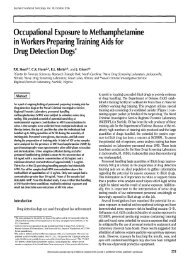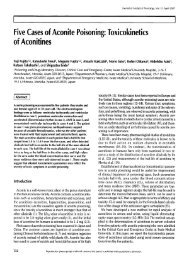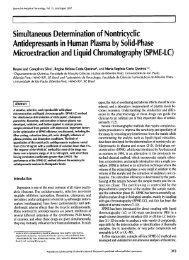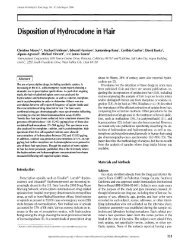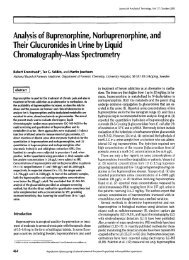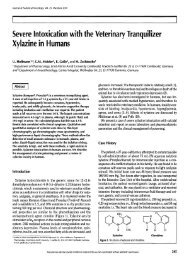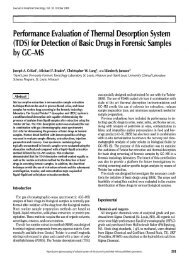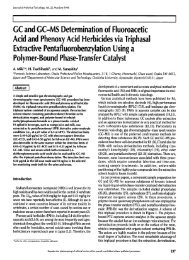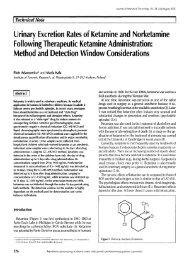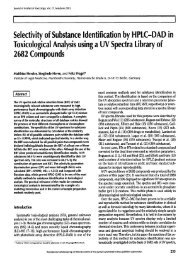Technical Note ] Importance of Vacutainer Selection in Forensic ...
Technical Note ] Importance of Vacutainer Selection in Forensic ...
Technical Note ] Importance of Vacutainer Selection in Forensic ...
Create successful ePaper yourself
Turn your PDF publications into a flip-book with our unique Google optimized e-Paper software.
Journal <strong>of</strong> Analytical Toxicology, Vol. 25, July/August 2001<br />
<strong>Importance</strong> <strong>of</strong> <strong>Vacuta<strong>in</strong>er</strong> <strong>Selection</strong> <strong>in</strong> <strong>Forensic</strong><br />
Toxicological Analysis <strong>of</strong> Drugs <strong>of</strong> Abuse<br />
Stefan W. Toennes* and Gerold F. Kauert<br />
Institute <strong>of</strong> <strong>Forensic</strong> Toxicology, University <strong>of</strong> Frankfurt, Kennedyallee 104, D-60596 Frankfurt~Ma<strong>in</strong>, Germany<br />
Abstract<br />
The enzymatic degradation <strong>of</strong> coca<strong>in</strong>e <strong>in</strong> blood samples, even<br />
dur<strong>in</strong>g transport to a forensic laboratory, is a common problem <strong>in</strong><br />
toxicological analysis. This can be avoided by the use <strong>of</strong> blood-<br />
sampl<strong>in</strong>g devices such as gray-top <strong>Vacuta<strong>in</strong>er</strong>s conta<strong>in</strong><strong>in</strong>g the<br />
chol<strong>in</strong>esterase <strong>in</strong>hibitor sodium fluoride. In the present study,<br />
which <strong>in</strong>cluded 147 authentic cases, blood samples were<br />
collected <strong>in</strong>to two different tubes, one conta<strong>in</strong><strong>in</strong>g fluoride/oxalate<br />
and one without stabiliz<strong>in</strong>g agents. In all cases, both samples<br />
were analyzed for drugs <strong>of</strong> abuse us<strong>in</strong>g Abbott FPIA<br />
immunoassays after precipitation and gas chromatography-mass<br />
spectrometry (GC-MS) for quantitative analysis. The cannab<strong>in</strong>oid<br />
immunoassay showed markedly lower values <strong>in</strong> the fluoride-<br />
conta<strong>in</strong><strong>in</strong>g samples; this was <strong>in</strong>vestigated further and could be<br />
expla<strong>in</strong>ed by hemolysis <strong>of</strong> these samples. In addition, the<br />
concentrations <strong>of</strong> 11 -nor-Ag-tetrahydrocannab<strong>in</strong>ol-9-carboxylic<br />
acid (THCCOOH) were lower <strong>in</strong> these samples. A stability study<br />
with the THCCOOH acyl glucuronide showed that it is unstable<br />
<strong>in</strong> unpreserved serum, which could expla<strong>in</strong> our observation.<br />
GC-MS quantitative data for amphetam<strong>in</strong>e and derivatives,<br />
opiates, Ag-tetrahydrocannab<strong>in</strong>ol, and 11-hydroxy-Ag-<br />
tetrahydrocannab<strong>in</strong>ol were essentially identical; however, they<br />
also differed substantially for coca<strong>in</strong>e, cocaethylene, ecgon<strong>in</strong>e<br />
methylester, and benzoylecgon<strong>in</strong>e. Unexpectedly, the<br />
concentrations <strong>of</strong> benzoylecgon<strong>in</strong>e <strong>in</strong> unpreserved serum were<br />
almost half as high as <strong>in</strong> the fluoride-conta<strong>in</strong><strong>in</strong>g samples.<br />
Introduction<br />
The rapid enzymatic degradation <strong>of</strong> coca<strong>in</strong>e <strong>in</strong> blood samples<br />
even dur<strong>in</strong>g transport to a laboratory is a well-known problem <strong>in</strong><br />
forensic toxicology. Through the use <strong>of</strong> blood samples collected<br />
<strong>in</strong> gray-top <strong>Vacuta<strong>in</strong>er</strong> tubes (Becton Dick<strong>in</strong>son), which conta<strong>in</strong><br />
the anticoagulant potassium oxalate and the chol<strong>in</strong>esterase<br />
<strong>in</strong>hibitor sodium fluoride, enzymatic coca<strong>in</strong>e catabolism can be<br />
<strong>in</strong>hibited, at least for certa<strong>in</strong> period <strong>of</strong> time (1-3). Con-<br />
centrations <strong>of</strong> other drugs <strong>of</strong> abuse are reported to be unaffected<br />
dur<strong>in</strong>g storage (4-8). However, these studies were carried out<br />
mostly with reference substances only or without controls <strong>in</strong><br />
unstabilized material.<br />
* Author to whom correspondence should be addressed. E-maih toennes@em.uni-frankfurt,de.<br />
<strong>Technical</strong> <strong>Note</strong> ]<br />
In the present study, immunochemical and gas chromato-<br />
graphic-mass spectrometric (GC-MS) analysis data <strong>of</strong> drugs <strong>of</strong><br />
abuse from blood samples collected <strong>in</strong> forensic cases <strong>of</strong> suspected<br />
driv<strong>in</strong>g under the <strong>in</strong>fluence <strong>of</strong> drugs were compared. Blood sam-<br />
ples were taken from the subjects us<strong>in</strong>g two <strong>Vacuta<strong>in</strong>er</strong> tubes, one<br />
free <strong>of</strong> additives and one conta<strong>in</strong><strong>in</strong>g fluoride/oxalate as stabiliz<strong>in</strong>g<br />
agents (gray4op <strong>Vacuta<strong>in</strong>er</strong>). This study design allowed the direct<br />
comparison <strong>of</strong> the analytical results from the two types <strong>of</strong> blood<br />
sampl<strong>in</strong>g tubes us<strong>in</strong>g authentic material. New <strong>in</strong>formation on the<br />
stability <strong>of</strong> certa<strong>in</strong> metabolites could be obta<strong>in</strong>ed.<br />
Experimental<br />
Chemicals, reference standards, and apparatus<br />
The reference standards and their correspond<strong>in</strong>g deuterated<br />
<strong>in</strong>ternal standards were purchased from Radian (Promochem,<br />
Wesel, Germany), except for (1)-9-carboxy-11-nor-A94etrahydro-<br />
cannab<strong>in</strong>ol glucuronide (THCCOOH-glucuronide) 10 lJg/mL<br />
solution <strong>in</strong> methanol which was from Alltech (Deerfield, IL). The<br />
derivatization reagents N-methyl-N-(tert-butyldimethyl-silyl)-<br />
trifluoroacetamide (MTBSTFA), N-methyl-bis(trifluoroaceta-<br />
mide) (MBTFA), and methyl iodide were from Sigma (Munich,<br />
Germany). All other reagents and organic solvents were <strong>of</strong> analyt-<br />
ical grade and from Merck (Darmstadt, Germany).<br />
GC-MS analyses were performed on a Hewlett-Packard<br />
(Waldbronn, Germany) GC-MS (HP 5890 series II GC, HP 6890<br />
ALS, HP 5972 MSD) with an HP-5 MS capillary column (30 m x<br />
0.25-ram i.d., 0.25-1Jm film thickness). The carrier gas was<br />
helium with a flow rate <strong>of</strong> 1.0 mL/m<strong>in</strong>. The MS conditions were<br />
280~ transfer l<strong>in</strong>e temperature and 70 eV ionization energy.<br />
Data analysis was performed on a W<strong>in</strong>dows computer with HP<br />
ChemStation s<strong>of</strong>tware (Rev. C.03.00).<br />
Samples and study design<br />
In cooperation with the highway police (Hessen, Germany), a<br />
study was performed us<strong>in</strong>g 147 cases <strong>of</strong> suspected driv<strong>in</strong>g under<br />
drug <strong>in</strong>fluence. In each case, blood sampl<strong>in</strong>g was carried out<br />
us<strong>in</strong>g two 10-mL <strong>Vacuta<strong>in</strong>er</strong> tubes (Becton Dick<strong>in</strong>son,<br />
Heidelberg, Germany): one conta<strong>in</strong>ed 25 mg sodium fluoride and<br />
20 mg potassium oxalate as stabiliz<strong>in</strong>g reagents (equipped with<br />
gray rubber tops), and the other type was without additives (red<br />
rubber tops). In all cases ur<strong>in</strong>e samples were also available. Upon<br />
Reproduction (photocopy<strong>in</strong>g) <strong>of</strong> editorial content <strong>of</strong> this journal is prohibited without publisher's permission. 339
arrival <strong>in</strong> the laboratory, the <strong>Vacuta<strong>in</strong>er</strong> tubes were centrifuged<br />
for separation <strong>of</strong> serum (<strong>Vacuta<strong>in</strong>er</strong> tubes with coagulated blood,<br />
normal samples) or plasma (from blood <strong>in</strong> <strong>Vacuta<strong>in</strong>er</strong> tubes con-<br />
ta<strong>in</strong><strong>in</strong>g oxalate/fluoride additive, fluoride samples) and stored at<br />
4~ until analysis which was carried out with<strong>in</strong> two weeks.<br />
Immunological screen<strong>in</strong>g was performed us<strong>in</strong>g the automated<br />
AxSym analyzer (Abbott, Wiesbaden, Germany) with Abbott fluor-<br />
escence-polarization immunoassays (FPIA) Amphetam<strong>in</strong>e/<br />
Methamphetam<strong>in</strong>e II, Opiates U, Cannab<strong>in</strong>oids U, and Coca<strong>in</strong>e<br />
Metabolite U; cut<strong>of</strong>f levels <strong>in</strong> ur<strong>in</strong>e were 300 ng/mL, 200 ng/mL,<br />
25 ng/mL, and 200 ng/mL, respectively. Ur<strong>in</strong>e samples were <strong>in</strong>i-<br />
tially analyzed immunologically, and if a positive result was<br />
obta<strong>in</strong>ed, the serum and plasma samples were tested us<strong>in</strong>g the<br />
same immunoassays. If at least one <strong>of</strong> the two samples tested pos-<br />
itive, quantitative analysis with GC-MS was performed.<br />
Immunological screen<strong>in</strong>g for drugs <strong>of</strong> abuse <strong>in</strong> serum/plasma<br />
with Abbott FPIA<br />
For prote<strong>in</strong> separation, 400 tJL <strong>of</strong> serum/plasma was added drop-<br />
wise to 400 IJL <strong>of</strong> acetone. The solution was vortex mixed and cen-<br />
trifuged for 10 m<strong>in</strong> at 1900 xg. The supernatant was analyzed by the<br />
Abbott FPIA tests. Accord<strong>in</strong>g to the results <strong>of</strong> a previous study (9),<br />
the follow<strong>in</strong>g cut<strong>of</strong>fvalues were used: 40 ng/mL for Amphetam<strong>in</strong>e/<br />
Methamphetam<strong>in</strong>e II, 40 ng/mL for Opiates U, 20 ng/mL for<br />
Cannab<strong>in</strong>oids U, and 20 ng/mL for Coca<strong>in</strong>e Metabolite U.<br />
Influence <strong>of</strong> the fluoride/oxalate additives on the FPIA results<br />
Two blood samples were obta<strong>in</strong>ed from each <strong>of</strong> six healthy non-<br />
drug users us<strong>in</strong>g the two different <strong>Vacuta<strong>in</strong>er</strong> types (gray top and<br />
red top). Each blood sample was split: one part was immediately<br />
centrifuged for serum/plasma separation, and the other part was<br />
stored for two days at 4~ to allow the development <strong>of</strong> hemolysis,<br />
after which it was also centrifuged for serum/plasma separation.<br />
From each <strong>of</strong> these 24 serum/plasma samples, 5001JL was added<br />
dropwise to 500 IJL <strong>of</strong> acetone. After vortex mix<strong>in</strong>g, the samples<br />
were centrifuged for 10 m<strong>in</strong> at 1900 xg. To 500 tJL <strong>of</strong> the super-<br />
natant 25 IJL <strong>of</strong> a solution conta<strong>in</strong><strong>in</strong>g amphetam<strong>in</strong>e (1000 ng),<br />
benzoylecgon<strong>in</strong>e (1000 ng), morph<strong>in</strong>e (100 ng), and 11-nor-Ag-<br />
tetrahydrocannab<strong>in</strong>ol-9-carboxylic acid (THCCOOH) (40 rig) <strong>in</strong><br />
acetone was added. These preparations were analyzed <strong>in</strong> the<br />
Abbott AxSym analyzer. The Student's t-test was applied to test for<br />
significant differences.<br />
Determ<strong>in</strong>ation <strong>of</strong> basic analytes <strong>in</strong> serum/plasma by GC-MS<br />
Serum samples (1 mL) were diluted with 4 mL <strong>of</strong> 0.1M phos-<br />
phate buffer (pH 6.0), and 100 IJL <strong>of</strong> an <strong>in</strong>ternal standard solution<br />
(1 ng/lJL <strong>of</strong> amphetam<strong>in</strong>e-d5, 3,4-methylenedioxymetham-<br />
phetam<strong>in</strong>e-d5, morph<strong>in</strong>e-d3, code<strong>in</strong>e-d3, coca<strong>in</strong>e-d3, benzoylec-<br />
gon<strong>in</strong>e-d3, and ecgon<strong>in</strong>e methylester-d3 <strong>in</strong> acetonitrile) was<br />
added. The samples were vortex mixed. The diluted samples were<br />
extracted us<strong>in</strong>g 3-mL Bond Elut Certify HF 300-mg solid-phase<br />
extraction (SPE) cartridges (Varian, Darmstadt, Germany) with<br />
the extraction robot RapidTrace (Zymark, Idste<strong>in</strong>, Germany). The<br />
extraction protocol was as follows: condition<strong>in</strong>g with 2 mL<br />
methanol and 3 mL phosphate buffer, application <strong>of</strong> the sample<br />
onto the column at 1 mL/m<strong>in</strong>, r<strong>in</strong>s<strong>in</strong>g with 2 mL 0.1M acetic acid<br />
and 3 mL methanol at 1.5 mL/m<strong>in</strong>, and elution <strong>of</strong> the analytes<br />
with 3 mL <strong>of</strong> freshly prepared solution <strong>of</strong> methylene chloride/2-<br />
340<br />
Journal <strong>of</strong> Analytical Toxicology, Vol. 25, July/August 2001<br />
propanol/concentrated aqueous ammonium hydroxide (80:20:2,<br />
v/v/v) at I mL/m<strong>in</strong>. The extracts were evaporated, the dry residue<br />
was derivatized with 40 IJL MBTFA followed by derivatization with<br />
30 IJL MTBSTFA, and 1 tJL <strong>of</strong> this solution was analyzed by<br />
GC-MS. GC conditions were as follows: <strong>in</strong>jection port tempera-<br />
ture 260~ held at 60~ for 2 m<strong>in</strong>, <strong>in</strong>creased to 170~ at<br />
20~ then to 310~ at 12~ and held for 5 m<strong>in</strong>.<br />
Quantitation <strong>of</strong> amphetam<strong>in</strong>e, 3,4-methylenedioxymetham-<br />
phetam<strong>in</strong>e (MDMA), 3,4-methylenedioxyamphetam<strong>in</strong>e (MDA),<br />
3,4-methylenedioxyethamphetam<strong>in</strong>e (MDEA), morph<strong>in</strong>e, 6-<br />
monoacetylmorph<strong>in</strong>e, code<strong>in</strong>e, dihydrocode<strong>in</strong>e, coca<strong>in</strong>e (COC),<br />
cocaethylene, and ecgon<strong>in</strong>e methylester (EME) as TFA derivatives<br />
and benzoylecgon<strong>in</strong>e (BZE) as tBDMS derivative was performed<br />
<strong>in</strong> s<strong>in</strong>gle ion monitor<strong>in</strong>g (SIM) mode us<strong>in</strong>g <strong>in</strong>ternal standards.<br />
Determ<strong>in</strong>ation <strong>of</strong> cannab<strong>in</strong>oids <strong>in</strong> serum/plasma by GC-MS<br />
For the determ<strong>in</strong>ation <strong>of</strong> the cannab<strong>in</strong>oids A9-tetrahydro-<br />
cannab<strong>in</strong>ol (THC), 11-hydroxy-A94etrahydrocannab<strong>in</strong>ol (THC-<br />
OH), and THCCOOH, 1 mL <strong>of</strong> serum/plasma was mixed with 4<br />
mL deionized water and 50 IJL <strong>of</strong> <strong>in</strong>ternal standard solution (0.5<br />
ng/IJL <strong>of</strong> THC-d3 and THC-OH-d3 and 2 ng/IJL <strong>of</strong> THCCOOH-d3 <strong>in</strong><br />
methanol), vortex mixed, and centrifuged for 10 m<strong>in</strong> at 1900 xg.<br />
Manual SPE was performed us<strong>in</strong>g 3-mL Bakerbond C18 500-rag<br />
cartridges (Baker, Griesheim, Germany) conditioned with 3 mL<br />
methanol and 2 x 3 mL water on a vacuum manifold. The sam-<br />
ples were slowly applied onto the columns (0.5 mL/m<strong>in</strong>). The<br />
columns were washed with 1 mL water, 1 mL 0.25M acetic acid,<br />
and 1 mL water, and vacuum was applied for 5 m<strong>in</strong>. The analytes<br />
were eluted with 3 x 0.5 mL acetone, and the eluate was evapo-<br />
rated to dryness. The residue was derivatized us<strong>in</strong>g methyl iodide,<br />
re-extracted with isooctane, and evaporated aga<strong>in</strong>. The residue<br />
was dissolved <strong>in</strong> 50 IJL isooctane, and 1 IJL was analyzed by<br />
GC-MS. GC conditions were as follows: <strong>in</strong>jection port tempera-<br />
ture 250~ held at 100~ for 2 ra<strong>in</strong>, <strong>in</strong>creased to 310~ at<br />
30~ and held for 6 ra<strong>in</strong>. Quantitation <strong>of</strong>THC, THC-OH, and<br />
THCCOOH as methyl derivatives was performed <strong>in</strong> the SIM mode<br />
us<strong>in</strong>g <strong>in</strong>ternal standards.<br />
Study on the stability <strong>of</strong> coca<strong>in</strong>e <strong>in</strong> unpreserved serum<br />
TWenty milliliters <strong>of</strong> pooled blank serum (pH 7.5) was spiked<br />
with coca<strong>in</strong>e to obta<strong>in</strong> 1 tJg/mL and <strong>in</strong>cubated <strong>in</strong> a 25~ water<br />
bath for 80 h. At selected times, 1-mL aliquots were analyzed for<br />
COC, EME, and BZE by GC-MS.<br />
Study on the stability <strong>of</strong> benzoylecgon<strong>in</strong>e <strong>in</strong><br />
unpreserved serum<br />
Ten milliliters <strong>of</strong> pooled blank serum (pH 7.5) was spiked with<br />
BZE to obta<strong>in</strong> 1 IJg/mL and <strong>in</strong>cubated <strong>in</strong> a 25~ water bath. At 0,<br />
15, 23, and 38 h, two 1-mL aliquots were analyzed for BZE by<br />
GC-MS.<br />
Study on the stability <strong>of</strong> THCCOOH-glucuronide <strong>in</strong><br />
unpreserved serum and <strong>in</strong> fluoride/oxalate conta<strong>in</strong><strong>in</strong>g plasma<br />
Blood from a healthy non-drug user was collected <strong>in</strong> vacu-<br />
ta<strong>in</strong>ers with and without fluoride/oxalate and centrifuged for<br />
serum/plasma separation. Aliquots <strong>of</strong> 5 mL <strong>of</strong> the unpreserved<br />
serum and <strong>of</strong> the fluoride/oxalate plasma were each spiked with a<br />
solution <strong>of</strong> THCCOOH-glucuronide to conta<strong>in</strong> 37.8, 75.6, or
Journal <strong>of</strong> Analytical Toxicology, Vol. 25, July/August 2001<br />
151.2 ng THCCOOH-glucuronide per milliliter <strong>of</strong> serum/plasma<br />
(equivalent to 25, 50, or 100 ng/mL THCCOOH). The spiked sam-<br />
ples were <strong>in</strong>cubated <strong>in</strong> a 25~ water bath for 250 h, and at selected<br />
times, 1-mL aliquots were analyzed for THCCOOH by GC-MS.<br />
The residue <strong>of</strong> the unpreserved blood sample, which conta<strong>in</strong>ed<br />
the erythrocytes, was washed three times with aqueous 0.9%<br />
sodium chloride solution to completely remove serum compo-<br />
nents and was reconstituted with the sodium chloride solution to<br />
the orig<strong>in</strong>al volume <strong>of</strong> the blood sample. A 10-mL aliquot was<br />
spiked with THCCOOH-glucuronide to conta<strong>in</strong> 37.8 ng/mL<br />
(equivalent to 25 ng/mL THCCOOH). The sample was <strong>in</strong>cubated<br />
18o Coca<strong>in</strong>e 350<br />
~. 160 "st" ~" 300<br />
140 E<br />
~120 + ~ 250<br />
8 1oo 8 200<br />
2000<br />
,~1500<br />
1000<br />
c<br />
0<br />
0 500<br />
+ ,-<br />
+ ++O ~_<br />
0<br />
29 pairs <strong>of</strong> samples<br />
45 pairs <strong>of</strong> samples<br />
Figure 1. Concentrations <strong>of</strong> coca<strong>in</strong>e, benzoylecgon<strong>in</strong>e, ecgon<strong>in</strong>emethylester and THCCOOH measured<br />
with GC-MS <strong>in</strong> serum from normal <strong>Vacuta<strong>in</strong>er</strong>s (O, ascend<strong>in</strong>g order) and <strong>in</strong> the correspond<strong>in</strong>g<br />
plasma from <strong>Vacuta<strong>in</strong>er</strong>s conta<strong>in</strong><strong>in</strong>g fluoride/oxalate (+).<br />
150 1<br />
Ecgon<strong>in</strong>e methylestsr<br />
:= 80 + ~ 150<br />
O +<br />
r<br />
60<br />
40 20 a,,~<br />
0 ........<br />
--[-<br />
+ _t_t _[_ .st. _t_.t_<br />
.'~..'~..'~.~.'~.C'~"i.'~..']..'].~.']..'~.~.'].<br />
~<br />
=.-<br />
0<br />
0 +<br />
100<br />
ooOO+ +<br />
50<br />
~_ .,~. ~i~+ +++ ++<br />
0<br />
19 pairs <strong>of</strong> samples<br />
20 pairs <strong>of</strong> samples<br />
7<br />
3500<br />
3000<br />
,.~2500<br />
Benzoylecgon<strong>in</strong>e<br />
+ ~<br />
2501 THCCOOH<br />
200<br />
0<br />
i'!<br />
~2-<br />
s-<br />
o<br />
,i<br />
I_<br />
c l-<br />
G)<br />
c<br />
o<br />
0<br />
0 =,<br />
xO<br />
\<br />
'x%\%<br />
1~176 1<br />
5o - .<br />
. . . .<br />
20 40 60 8<br />
Incubation time <strong>in</strong> serum at 25~ (h)<br />
Figure 2. Degradation <strong>of</strong> coca<strong>in</strong>e (I), 1000 ng/mL spiked) to benzoylecgon<strong>in</strong>e (O), and ecgon<strong>in</strong>e<br />
methylester (A) <strong>in</strong> serum at 25~ The sum <strong>of</strong> the molar concentrations <strong>of</strong> coca<strong>in</strong>e, benzoylecgon<strong>in</strong>e,<br />
and ecgon<strong>in</strong>e methylester at each time is given (9 together with the result <strong>of</strong> an exponential regres-<br />
sion <strong>of</strong> these data (dashed l<strong>in</strong>e).<br />
<strong>in</strong> a 25~ water bath for 250 h, and at selected times, 1-mL<br />
aliquots were analyzed for THCCOOH by GC-MS.<br />
Results and Discussion<br />
The aim <strong>of</strong> the present study was to <strong>in</strong>vestigate possible differences<br />
<strong>in</strong> results obta<strong>in</strong>ed by analyz<strong>in</strong>g blood samples collected <strong>in</strong><br />
<strong>Vacuta<strong>in</strong>er</strong> tubes with and without stabiliz<strong>in</strong>g additives. Such differences<br />
have already been observed <strong>in</strong> the preanalytical phase. An<br />
effect <strong>of</strong> the sodium fluoride was that all plasma<br />
samples became markedly hemolytic, and the volo<br />
umes <strong>of</strong> the plasma samples were higher because<br />
o <strong>of</strong> the anticoagulant potassium oxalate.<br />
#<br />
Immunological screen<strong>in</strong>g for drugs <strong>of</strong> abuse <strong>in</strong><br />
serum/plasma with Abbott FPIA<br />
To some extent, the results <strong>of</strong> the immunoas-<br />
says <strong>in</strong> normal serum and fluoride plasma for<br />
amphetam<strong>in</strong>e and derivatives (79 cases), opiates<br />
(40 cases), cannab<strong>in</strong>oids (65 cases), and coca<strong>in</strong>e<br />
(46 cases) showed considerable differences. The<br />
values for opiates and amphetam<strong>in</strong>e did not differ<br />
markedly <strong>in</strong> average, but <strong>in</strong> the case <strong>of</strong> the assay<br />
Coca<strong>in</strong>e Metabolite U, the values <strong>in</strong> the fluoride<br />
samples were, on average, twice as high as the<br />
values <strong>in</strong> the normal samples. For the cannabi-<br />
noid assay, the results <strong>of</strong> the fluoride samples<br />
were, on average, only half as high as the values <strong>in</strong><br />
the normal samples, which caused a higher rate <strong>of</strong><br />
false negatives (28% vs. 5% <strong>in</strong> normal samples).<br />
Influence <strong>of</strong> the additives on FPIA results<br />
Drug-free serum/plasma samples were spiked<br />
just before measurement to elim<strong>in</strong>ate any differ-<br />
ences due to sample preparation. The assays <strong>of</strong> all<br />
six samples were reproducible with variation coef-<br />
ficients <strong>of</strong> less than 8%. When serum/plasma was<br />
separated immediately after blood sampl<strong>in</strong>g, none<br />
<strong>of</strong> these samples was hemolytic, and no significant<br />
differences <strong>in</strong> the FPIA values were observed, <strong>in</strong>di-<br />
cat<strong>in</strong>g that the additives themselves did not affect<br />
the measurement. This is <strong>in</strong> agreement with<br />
results obta<strong>in</strong>ed by Rob<strong>in</strong>son and Smith (10) for<br />
an immunoassay <strong>of</strong> tricyclic antidepressants.<br />
Dur<strong>in</strong>g storage for two days, hemolysis developed<br />
<strong>in</strong> the fluoride/oxalate-conta<strong>in</strong><strong>in</strong>g blood samples.<br />
FPIA values <strong>in</strong> the fluoride/oxalate-conta<strong>in</strong><strong>in</strong>g<br />
samples before and after storage did not differ<br />
except for the assay Cannab<strong>in</strong>oids U, where the<br />
values obta<strong>in</strong>ed <strong>in</strong> the hemolytic samples were<br />
significantly lower by 39% (p < 0.001). This effect<br />
must therefore be attributed to hemolysis.<br />
Quantitative analyses <strong>in</strong> serum/plasma by GC-MS<br />
No differences could be observed dur<strong>in</strong>g extrac-<br />
tion and GC-MS analysis between the two sample<br />
341
types; GC-MS signals <strong>of</strong> analytes and matrix compounds <strong>in</strong> SIM<br />
mode showed no differences. No differences <strong>in</strong> the quantitative<br />
results could be found for the analytes amphetam<strong>in</strong>e (49 cases),<br />
MDMA (23 cases), MDA (16 cases), morph<strong>in</strong>e (14 cases), code<strong>in</strong>e<br />
(13 cases), dihydrocode<strong>in</strong>e (3 cases), THC (35 cases), and THC-<br />
OH (32 cases). However, clear differences were observed for<br />
coca<strong>in</strong>e, its metabolites (29 cases), and THCCOOH (45 cases) as<br />
shown <strong>in</strong> Figure 1.<br />
Stability <strong>of</strong> coca<strong>in</strong>e and its metabolites <strong>in</strong> serum/plasma<br />
In 29 cases, benzoylecgon<strong>in</strong>e was determ<strong>in</strong>ed as evidence <strong>of</strong><br />
previous coca<strong>in</strong>e use. Coca<strong>in</strong>e itself was not found <strong>in</strong> any <strong>of</strong> the<br />
normal samples, but <strong>in</strong> 65% <strong>of</strong> the fluoride samples. Coc-<br />
aethylene was present <strong>in</strong> two <strong>of</strong> the fluoride samples (8%), con-<br />
firm<strong>in</strong>g that fluoride has a stabiliz<strong>in</strong>g effect on coca<strong>in</strong>e and<br />
cocaethylene. It was surpris<strong>in</strong>g that the concentrations <strong>of</strong> ben-<br />
zoylecgon<strong>in</strong>e <strong>in</strong> the fluoride samples were almost twice as high<br />
(compare immunological results) and those <strong>of</strong> ecgon<strong>in</strong>e<br />
methylester were almost half when compared to those <strong>of</strong> the<br />
normal samples (Figure 1).<br />
In serum without additives, coca<strong>in</strong>e is rapidly hydrolyzed enzy-<br />
matically to ecgon<strong>in</strong>e methylester as has been shown <strong>in</strong> various<br />
studies (3) and <strong>in</strong> the present study (Figure 2). In contrast to<br />
Isenschmid et al. (3), it was found that coca<strong>in</strong>e was also<br />
hydrolyzed to benzoylecgon<strong>in</strong>e, but only to a m<strong>in</strong>or extent, which<br />
is <strong>in</strong> accordance with Stewart et al. (11). Ecgon<strong>in</strong>e methylester<br />
and benzoylecgon<strong>in</strong>e were also <strong>in</strong>stable and were further<br />
hydrolyzed to ecgon<strong>in</strong>e. The overall degradation process could be<br />
assessed by add<strong>in</strong>g the molar concentrations <strong>of</strong> coca<strong>in</strong>e, ecgon<strong>in</strong>e<br />
methylester, and benzoylecgon<strong>in</strong>e and perform<strong>in</strong>g an exponential<br />
regression analysis which yielded a half-life <strong>of</strong> 15 h (equation:<br />
y = 4.22 e 4)'0462 x x, regression coefficient 0.991, Figure 2).<br />
The differences observed between the data obta<strong>in</strong>ed by ana-<br />
lyz<strong>in</strong>g the normal and the fluoride samples are ma<strong>in</strong>ly due to the<br />
fluoride-mediated <strong>in</strong>hibition <strong>of</strong> the plasma chol<strong>in</strong>esterase<br />
(PChE). Consequently, ecgon<strong>in</strong>e methylester concentrations<br />
were lower <strong>in</strong> the fluoride samples because enzymatic hydrolysis<br />
<strong>of</strong> coca<strong>in</strong>e to ecgon<strong>in</strong>e methylester was <strong>in</strong>hibited.<br />
The literature reports on the stability <strong>of</strong> benzoylecgon<strong>in</strong>e are<br />
35%<br />
0 25%<br />
"o ~ 20%<br />
P<br />
15%<br />
,o%<br />
=<br />
I-- 0%<br />
0 50 I00 150 200 250<br />
Incubation time (h)<br />
Figure 3. Percentage <strong>of</strong> hydrolyzed THCCOOH-glucuronide <strong>in</strong> serum from<br />
normal <strong>Vacuta<strong>in</strong>er</strong>s (O) and <strong>in</strong> plasma from <strong>Vacuta<strong>in</strong>er</strong>s conta<strong>in</strong><strong>in</strong>g<br />
fluoride/oxalate (I-l) at 25~ For each type <strong>of</strong> material are shown the average<br />
and standard deviation from three different concentrations <strong>of</strong> THCCOOHg[ucuronide<br />
(37.8, 75.6, and 151.2 ng/mL spiked).<br />
342<br />
Duma[ <strong>of</strong> Analytical Toxicology, Vo[. 25, July/August 2001<br />
controversial. An enzymatic hydrolysis <strong>of</strong> benzoylecgon<strong>in</strong>e to<br />
ecgon<strong>in</strong>e like coca<strong>in</strong>e to ecgon<strong>in</strong>e methylester could be expected;<br />
however, some authors suggest that benzoylecgon<strong>in</strong>e is stable <strong>in</strong><br />
unpreserved serum (3,8,12). Stewart et al. (11) found a constant,<br />
but slow hydrolysis <strong>in</strong> unstabilized serum samples that was<br />
expla<strong>in</strong>ed by a low aff<strong>in</strong>ity <strong>of</strong> benzoylecgon<strong>in</strong>e to the enzyme<br />
PChE. Giorgi and Meeker (7) and Moody et al. (13) reported a sub-<br />
stantial decrease <strong>of</strong> benzoylecgon<strong>in</strong>e concentrations <strong>in</strong> blood sam-<br />
ples stabilized with fluoride, but Baselt et al. (5) reported that<br />
benzoylecgon<strong>in</strong>e was stable <strong>in</strong> blood for one year <strong>in</strong> evacuated col-<br />
lection tubes conta<strong>in</strong><strong>in</strong>g 100 mg sodium fluoride and 20 mg potas-<br />
sium oxalate. Therefore, an experiment was performed <strong>in</strong> order to<br />
test the stability <strong>of</strong> benzoylecgon<strong>in</strong>e <strong>in</strong> unstabilized serum. A<br />
sample conta<strong>in</strong><strong>in</strong>g benzoylecgon<strong>in</strong>e <strong>in</strong> a concentration <strong>of</strong> 1000<br />
ng/mL and <strong>in</strong>cubated at 25~ exhibited a l<strong>in</strong>ear decrease <strong>of</strong> 13 ng<br />
BZE/mL per hour (regression coefficient 0.997). The benzoylecgo-<br />
n<strong>in</strong>e concentration was reduced to almost half <strong>of</strong> the <strong>in</strong>itial value<br />
dur<strong>in</strong>g the 38 h <strong>of</strong> <strong>in</strong>cubation. Such a delay may be reached easily<br />
when a blood sample is sent by mail. The observed differences <strong>of</strong><br />
the benzoylecgon<strong>in</strong>e concentrations between the normal samples<br />
and the fluoride samples can therefore be expla<strong>in</strong>ed by the hydro-<br />
lysis <strong>of</strong> benzoylecgon<strong>in</strong>e <strong>in</strong> unpreserved samples.<br />
Stability <strong>of</strong> THCCOOH-glucuronide <strong>in</strong> serum/plasma<br />
The cannab<strong>in</strong>oid immunoassay is designed to measure THC-<br />
COOH. The observation that the immunological values <strong>in</strong> the flu-<br />
oride samples were about half as high as <strong>in</strong> the normal samples<br />
could be expla<strong>in</strong>ed by the f<strong>in</strong>d<strong>in</strong>g that hemolysis <strong>in</strong> the fluoride<br />
samples markedly affects FPIA measurement. Surpris<strong>in</strong>gly, the<br />
GC-MS confirmation analyses showed that, <strong>in</strong> 90% <strong>of</strong> the fluoride<br />
samples, the THCCOOH concentrations were on average 32%<br />
lower than <strong>in</strong> the normal samples. Previous studies suggested<br />
that THC, THC-OH, and THCCOOI-I are stable <strong>in</strong> blood and<br />
plasma dur<strong>in</strong>g storage for several months (8,13-17). A possible<br />
explanation for our f<strong>in</strong>d<strong>in</strong>g would be a conjugate <strong>of</strong> THCCOOH<br />
that is unstable, probably susceptible to degradation by serum<br />
esterases. Such a metabolite could be the ester glucuronide <strong>of</strong><br />
THCCOOH (18) (THCCOOH-glucuronide). Therefore, we <strong>in</strong>vesti-<br />
gated the stability <strong>of</strong> the THCCOOH-glucuronide <strong>in</strong> blood sam-<br />
ples with and without stabiliz<strong>in</strong>g agents.<br />
The THCCOOH-glucuronide was stable under the conditions <strong>of</strong><br />
the analytical procedure as immediately after spik<strong>in</strong>g <strong>of</strong> the sam-<br />
ples no THCCOOH was detectable. No THCCOOH developed<br />
dur<strong>in</strong>g the <strong>in</strong>cubation <strong>of</strong> THCCOOH-glucuronide <strong>in</strong> suspended<br />
erythrocytes, <strong>in</strong>dicat<strong>in</strong>g that the erythrocytes had no <strong>in</strong>fluence on<br />
the stability <strong>of</strong> the glucuronide. Dur<strong>in</strong>g <strong>in</strong>cubation <strong>of</strong> THCCOOH-<br />
glucuronide <strong>in</strong> serum or fluoride/oxalate conta<strong>in</strong><strong>in</strong>g plasma,<br />
THCCOOH could be detected <strong>in</strong> <strong>in</strong>creas<strong>in</strong>g concentrations. The<br />
absolute concentrations were dependent on the <strong>in</strong>itial amount <strong>of</strong><br />
glucuronide but <strong>in</strong> each group (with or without fluoride/oxalate)<br />
the THCCOOH concentration relative to the maximum theoret-<br />
ical yield were reproducible (Figure 3). The concentrations at 139<br />
or 236 h <strong>in</strong>cubation time were significantly lower <strong>in</strong> the fluor-<br />
ide/oxalate plasma samples than <strong>in</strong> the unstabilized serum sam-<br />
ples (p < 0.01) prov<strong>in</strong>g that the addition <strong>of</strong> fluoride/oxalate had<br />
<strong>in</strong>deed a stabiliz<strong>in</strong>g effect on the THC metabolite THCCOOH-glu-<br />
curonide. This is probably the explanation for the lower concen-<br />
trations <strong>of</strong> THCCOOH <strong>in</strong> the fluoride samples.
Journal <strong>of</strong> Analytical Toxicology, Vol. 25, July/August 2001<br />
Conclusions<br />
In authentic cases, two blood samples were collected <strong>in</strong> tubes<br />
with and without the stabiliz<strong>in</strong>g agents fluoride and oxalate.<br />
Analysis results <strong>of</strong> drugs <strong>of</strong> abuse us<strong>in</strong>g immunoassays and<br />
GC-MS differed markedly for THCCOOH and coca<strong>in</strong>e and its<br />
metabolites. The cannab<strong>in</strong>oid immunoassay was shown to be sus-<br />
ceptible to hemolysis that developed <strong>in</strong> fluoride-conta<strong>in</strong><strong>in</strong>g sam-<br />
ples. Furthermore, GC-MS quantitative analyses revealed lower<br />
concentrations <strong>of</strong> THCCOOH <strong>in</strong> fluoride-conta<strong>in</strong><strong>in</strong>g samples,<br />
which could be expla<strong>in</strong>ed by the lower stability <strong>of</strong> the THCCOOH-<br />
glucuronide <strong>in</strong> unpreserved serum. Degradation <strong>of</strong> coca<strong>in</strong>e and<br />
cocaethylene to ecgon<strong>in</strong>e esters was <strong>in</strong>hibited <strong>in</strong> fluoride-con-<br />
ta<strong>in</strong><strong>in</strong>g samples, but the massive enzymatic hydrolysis <strong>of</strong> ben-<br />
zoylecgon<strong>in</strong>e that also occurred <strong>in</strong> the unstabilized samples was<br />
unexpected.<br />
References<br />
1. R.C. Baselt, R.F. Shaw, and R. McEvilly. Effect <strong>of</strong> sodium fluoride on<br />
chol<strong>in</strong>esterase activity <strong>in</strong> postmortem blood. J. <strong>Forensic</strong> Sci. 30:<br />
1206-1209 (1985).<br />
2. P. Bouis, G. Taccard, and U.A. Boelsterli. Determ<strong>in</strong>ation <strong>of</strong> coca<strong>in</strong>e<br />
and norcoca<strong>in</strong>e <strong>in</strong> plasma and cell cultures us<strong>in</strong>g high-performance<br />
liquid chromatography. J. Chromatogr. 526:447-459 (1990).<br />
3. D.S. Isenschmid, B.S. Lev<strong>in</strong>e, and Y.H. Caplan. A comprehensive<br />
study <strong>of</strong> the stability <strong>of</strong> coca<strong>in</strong>e and its metabolites. J. AnaL Toxicol.<br />
13' 250-256 (1989).<br />
4. R.C. Baselt. Stability <strong>of</strong> coca<strong>in</strong>e <strong>in</strong> biological fluids. J. Chromatogr.<br />
268:502-505 (1983).<br />
5. R.C. Baselt, D. Yoshikawa, J. Chang, and J. Li. Improved long-term<br />
stability <strong>of</strong> blood coca<strong>in</strong>e <strong>in</strong> evacuated collection tubes. J. <strong>Forensic</strong><br />
ScL 38:935-937 (1993).<br />
6. W.C. Brogan, III, P.M. Kemp, R.O. Bost, D.B. Glamann, R.A. Lange,<br />
and L.D. Hillis. Collection and handl<strong>in</strong>g <strong>of</strong> cl<strong>in</strong>ical blood samples to<br />
assure the accurate measurement <strong>of</strong> coca<strong>in</strong>e concentration. J. Anal.<br />
Toxicol. 16" 152-I 54 (I 992).<br />
7. S.N. Giorgi and J.E. Meeker. A 5-year stability study <strong>of</strong> common<br />
illicit drugs <strong>in</strong> blood. J. Anal. Toxicol. 19:392-398 (I 995).<br />
8. H.H. McCurdy, L.S. Callahan, and R.D. Williams. Studies on the<br />
stability and detection <strong>of</strong> coca<strong>in</strong>e, benzoylecgon<strong>in</strong>e, and 11-nor-<br />
delta-9-tetrahydrocannab<strong>in</strong>ol-9-carboxylic acid <strong>in</strong> whole blood<br />
us<strong>in</strong>g Abuscreen radioimmunoassay. J. <strong>Forensic</strong> Sci. 34:858-870<br />
(1989).<br />
9. G. Kauert and K. Schmidt. Drogenscreen<strong>in</strong>g im Serum mittels<br />
immunchemischer Veffahren (FPIA) (<strong>in</strong> preparation).<br />
10. K. Rob<strong>in</strong>son and R.N. Smith. Radioimmunoassay <strong>of</strong>tricyclic antide-<br />
pressant and some phenothiaz<strong>in</strong>e drugs <strong>in</strong> forensic toxicology.<br />
J. Immunoassay6:11-22 (1985).<br />
11. D.J. Stewart, T. Inaba, M. Lucassen, and W. Kalow. Coca<strong>in</strong>e<br />
metabolism: coca<strong>in</strong>e and norcoca<strong>in</strong>e hydrolysis by liver and serum<br />
esterases. Cl<strong>in</strong>. PharmacoL Ther. 25:464-468 (1979).<br />
12. B.K. Logan and K.L. Peterson. The orig<strong>in</strong> and significance <strong>of</strong> ecgo-<br />
n<strong>in</strong>e methyl ester <strong>in</strong> blood samples. J. Anal Toxicol. 18:124-125<br />
(1994).<br />
13. D.E. Moody, K.M. Monti, and A.C. Spanbauer. Long-term stability <strong>of</strong><br />
abused drugs and antiabuse chemotherapeutical agents stored at<br />
-20~ J. Anal. Toxicol. 23:535-540 (1999).<br />
14. A.S. Christophersen. Tetrahydrocannab<strong>in</strong>ol stability <strong>in</strong> whole blood:<br />
plastic versus glass conta<strong>in</strong>ers. J. Anal. ToxicoL 10:129-131 (1986).<br />
15. C.R. Goodall and B.J. Basteyns. A reliable method for the detection,<br />
confirmation, and quantitation <strong>of</strong> cannab<strong>in</strong>oids <strong>in</strong> blood. J. Anal.<br />
ToxicoL 19:419-426 (1995).<br />
16. J.R. Johnson, T.A. Jennison, M.A. Peat, and R.L. Foltz. Stability <strong>of</strong><br />
delta 9-tetrahydrocannab<strong>in</strong>ol (THC), 11-hydroxy-THC, and 11-nor-<br />
9-carboxy-THC <strong>in</strong> blood and plasma. J. AnaL ToxicoL 8:202-204<br />
(1984).<br />
17. A.S. Wong, M.W. Orbanosky, V.C. Reeve, and J.D. Beede. Stability<br />
<strong>of</strong> delta-9-tetrahydrocannab<strong>in</strong>ol <strong>in</strong> stored blood and serum. NIDA<br />
Res. Monogr. 42:119-124 (1982).<br />
18. P.L. Williams and A.C. M<strong>of</strong>fat. Identification <strong>in</strong> human ur<strong>in</strong>e <strong>of</strong> delta<br />
9-tetrahydrocannab<strong>in</strong>ol-11-oic acid glucuronide: a tetrahydro-<br />
cannab<strong>in</strong>ol metabolite. J. Pharm. PharmacoL 32:445-448 (1980).<br />
Manuscript received July 13, 2000;<br />
revision received December 11, 2000.<br />
343


![Technical Note ] Importance of Vacutainer Selection in Forensic ...](https://img.yumpu.com/6394704/1/500x640/technical-note-importance-of-vacutainer-selection-in-forensic-.jpg)
